Nursing Professional Case Study 2022
VerifiedAdded on 2022/09/18
|8
|1872
|28
AI Summary
Contribute Materials
Your contribution can guide someone’s learning journey. Share your
documents today.
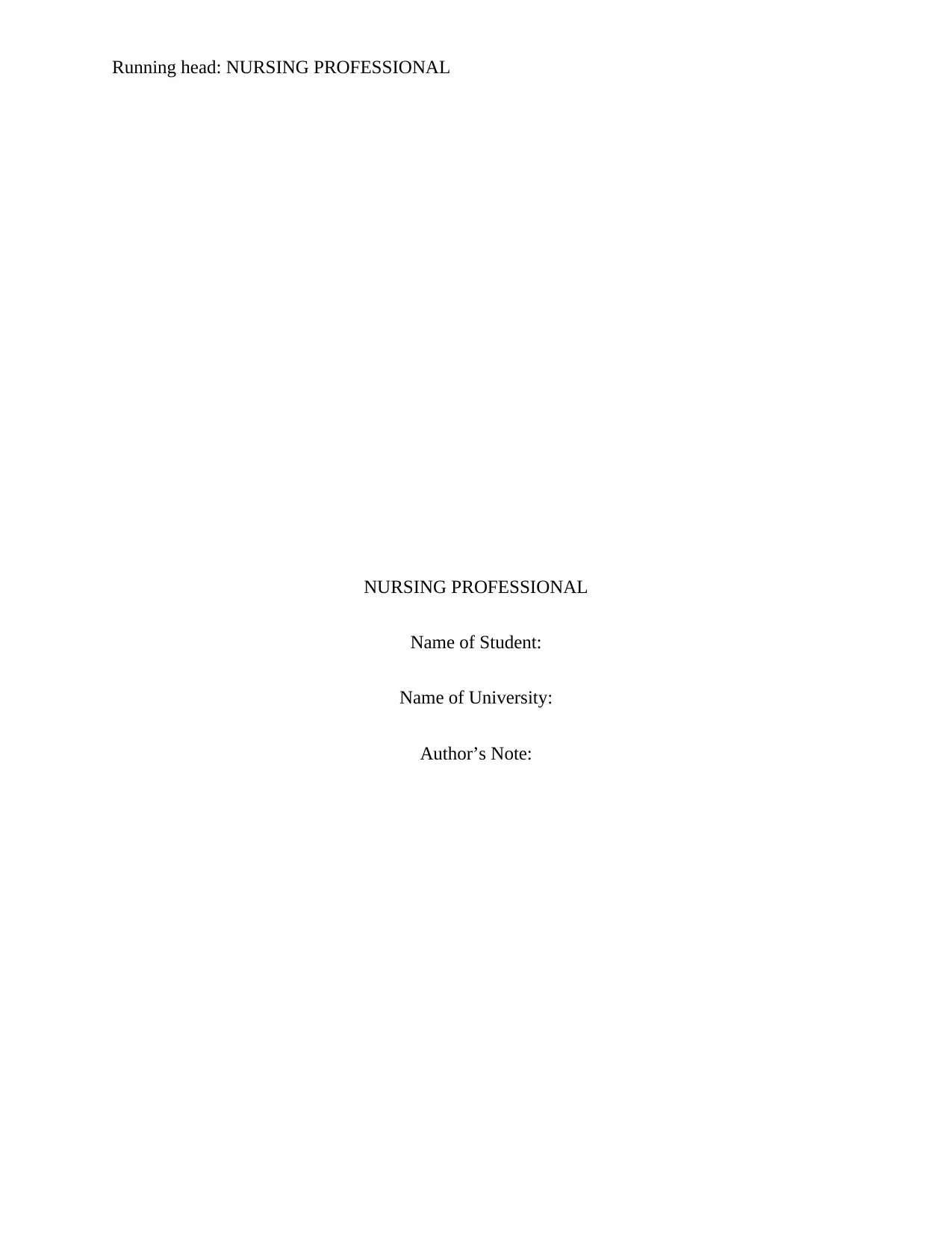
Running head: NURSING PROFESSIONAL
NURSING PROFESSIONAL
Name of Student:
Name of University:
Author’s Note:
NURSING PROFESSIONAL
Name of Student:
Name of University:
Author’s Note:
Secure Best Marks with AI Grader
Need help grading? Try our AI Grader for instant feedback on your assignments.
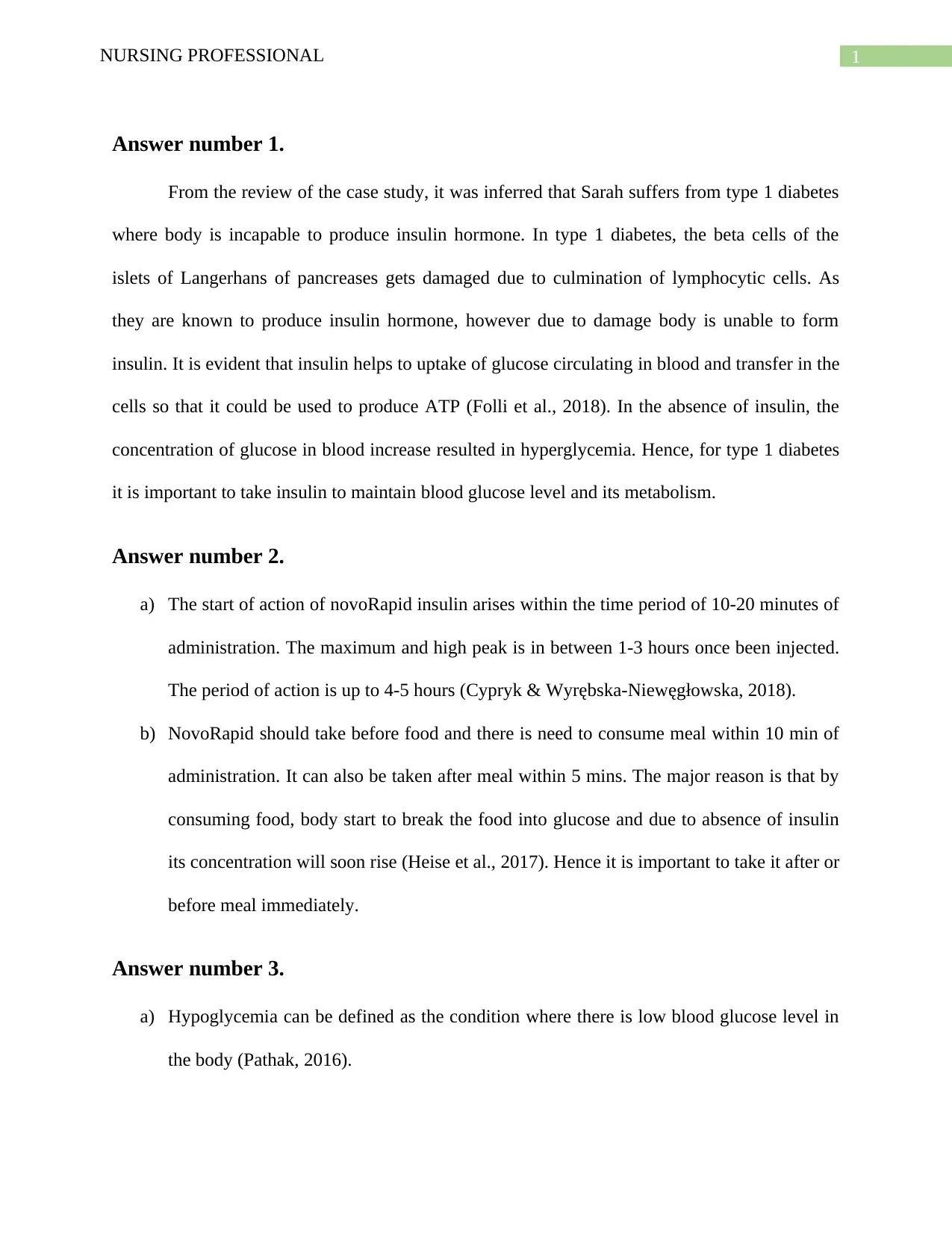
1NURSING PROFESSIONAL
Answer number 1.
From the review of the case study, it was inferred that Sarah suffers from type 1 diabetes
where body is incapable to produce insulin hormone. In type 1 diabetes, the beta cells of the
islets of Langerhans of pancreases gets damaged due to culmination of lymphocytic cells. As
they are known to produce insulin hormone, however due to damage body is unable to form
insulin. It is evident that insulin helps to uptake of glucose circulating in blood and transfer in the
cells so that it could be used to produce ATP (Folli et al., 2018). In the absence of insulin, the
concentration of glucose in blood increase resulted in hyperglycemia. Hence, for type 1 diabetes
it is important to take insulin to maintain blood glucose level and its metabolism.
Answer number 2.
a) The start of action of novoRapid insulin arises within the time period of 10-20 minutes of
administration. The maximum and high peak is in between 1-3 hours once been injected.
The period of action is up to 4-5 hours (Cypryk & Wyrębska-Niewęgłowska, 2018).
b) NovoRapid should take before food and there is need to consume meal within 10 min of
administration. It can also be taken after meal within 5 mins. The major reason is that by
consuming food, body start to break the food into glucose and due to absence of insulin
its concentration will soon rise (Heise et al., 2017). Hence it is important to take it after or
before meal immediately.
Answer number 3.
a) Hypoglycemia can be defined as the condition where there is low blood glucose level in
the body (Pathak, 2016).
Answer number 1.
From the review of the case study, it was inferred that Sarah suffers from type 1 diabetes
where body is incapable to produce insulin hormone. In type 1 diabetes, the beta cells of the
islets of Langerhans of pancreases gets damaged due to culmination of lymphocytic cells. As
they are known to produce insulin hormone, however due to damage body is unable to form
insulin. It is evident that insulin helps to uptake of glucose circulating in blood and transfer in the
cells so that it could be used to produce ATP (Folli et al., 2018). In the absence of insulin, the
concentration of glucose in blood increase resulted in hyperglycemia. Hence, for type 1 diabetes
it is important to take insulin to maintain blood glucose level and its metabolism.
Answer number 2.
a) The start of action of novoRapid insulin arises within the time period of 10-20 minutes of
administration. The maximum and high peak is in between 1-3 hours once been injected.
The period of action is up to 4-5 hours (Cypryk & Wyrębska-Niewęgłowska, 2018).
b) NovoRapid should take before food and there is need to consume meal within 10 min of
administration. It can also be taken after meal within 5 mins. The major reason is that by
consuming food, body start to break the food into glucose and due to absence of insulin
its concentration will soon rise (Heise et al., 2017). Hence it is important to take it after or
before meal immediately.
Answer number 3.
a) Hypoglycemia can be defined as the condition where there is low blood glucose level in
the body (Pathak, 2016).
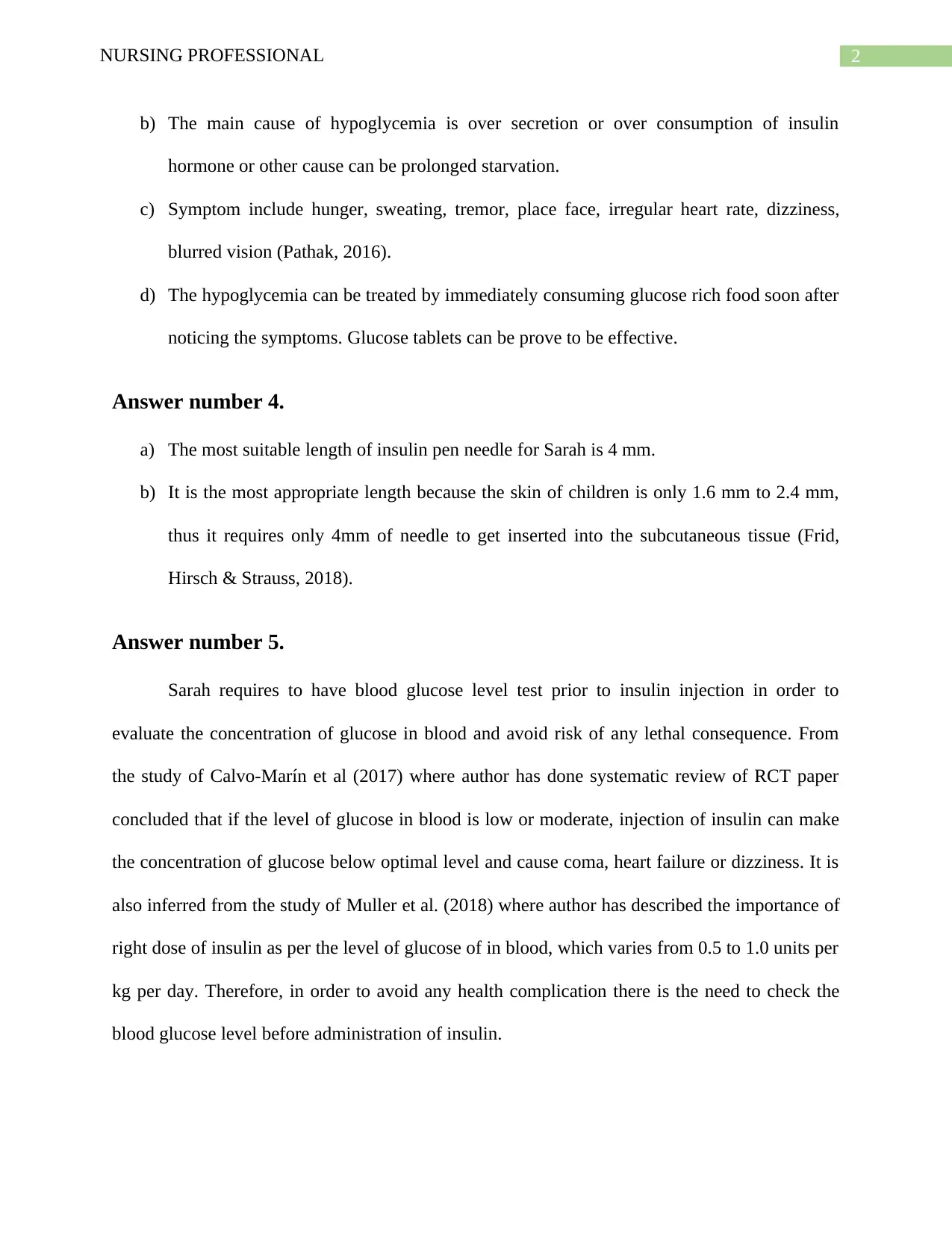
2NURSING PROFESSIONAL
b) The main cause of hypoglycemia is over secretion or over consumption of insulin
hormone or other cause can be prolonged starvation.
c) Symptom include hunger, sweating, tremor, place face, irregular heart rate, dizziness,
blurred vision (Pathak, 2016).
d) The hypoglycemia can be treated by immediately consuming glucose rich food soon after
noticing the symptoms. Glucose tablets can be prove to be effective.
Answer number 4.
a) The most suitable length of insulin pen needle for Sarah is 4 mm.
b) It is the most appropriate length because the skin of children is only 1.6 mm to 2.4 mm,
thus it requires only 4mm of needle to get inserted into the subcutaneous tissue (Frid,
Hirsch & Strauss, 2018).
Answer number 5.
Sarah requires to have blood glucose level test prior to insulin injection in order to
evaluate the concentration of glucose in blood and avoid risk of any lethal consequence. From
the study of Calvo-Marín et al (2017) where author has done systematic review of RCT paper
concluded that if the level of glucose in blood is low or moderate, injection of insulin can make
the concentration of glucose below optimal level and cause coma, heart failure or dizziness. It is
also inferred from the study of Muller et al. (2018) where author has described the importance of
right dose of insulin as per the level of glucose of in blood, which varies from 0.5 to 1.0 units per
kg per day. Therefore, in order to avoid any health complication there is the need to check the
blood glucose level before administration of insulin.
b) The main cause of hypoglycemia is over secretion or over consumption of insulin
hormone or other cause can be prolonged starvation.
c) Symptom include hunger, sweating, tremor, place face, irregular heart rate, dizziness,
blurred vision (Pathak, 2016).
d) The hypoglycemia can be treated by immediately consuming glucose rich food soon after
noticing the symptoms. Glucose tablets can be prove to be effective.
Answer number 4.
a) The most suitable length of insulin pen needle for Sarah is 4 mm.
b) It is the most appropriate length because the skin of children is only 1.6 mm to 2.4 mm,
thus it requires only 4mm of needle to get inserted into the subcutaneous tissue (Frid,
Hirsch & Strauss, 2018).
Answer number 5.
Sarah requires to have blood glucose level test prior to insulin injection in order to
evaluate the concentration of glucose in blood and avoid risk of any lethal consequence. From
the study of Calvo-Marín et al (2017) where author has done systematic review of RCT paper
concluded that if the level of glucose in blood is low or moderate, injection of insulin can make
the concentration of glucose below optimal level and cause coma, heart failure or dizziness. It is
also inferred from the study of Muller et al. (2018) where author has described the importance of
right dose of insulin as per the level of glucose of in blood, which varies from 0.5 to 1.0 units per
kg per day. Therefore, in order to avoid any health complication there is the need to check the
blood glucose level before administration of insulin.
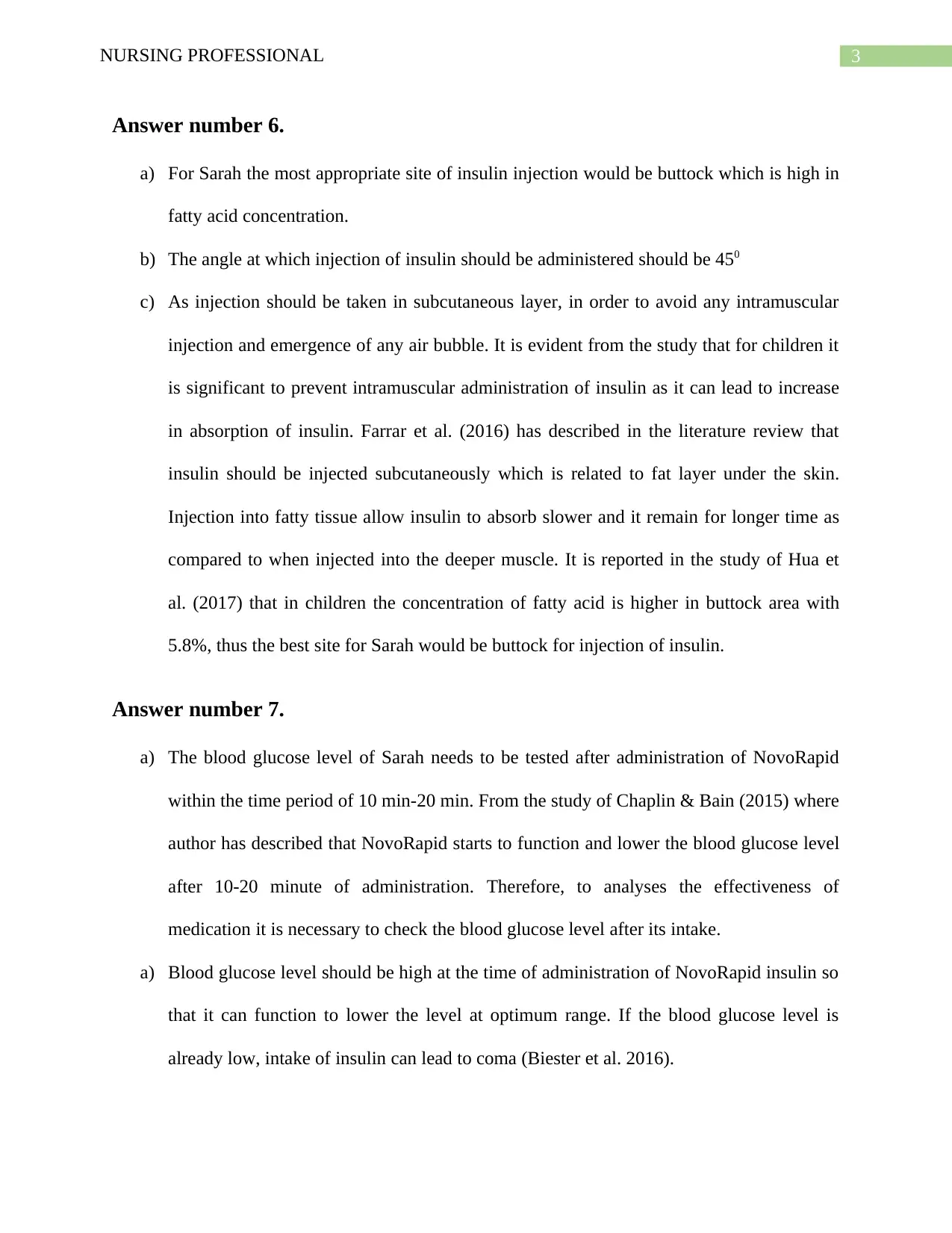
3NURSING PROFESSIONAL
Answer number 6.
a) For Sarah the most appropriate site of insulin injection would be buttock which is high in
fatty acid concentration.
b) The angle at which injection of insulin should be administered should be 450
c) As injection should be taken in subcutaneous layer, in order to avoid any intramuscular
injection and emergence of any air bubble. It is evident from the study that for children it
is significant to prevent intramuscular administration of insulin as it can lead to increase
in absorption of insulin. Farrar et al. (2016) has described in the literature review that
insulin should be injected subcutaneously which is related to fat layer under the skin.
Injection into fatty tissue allow insulin to absorb slower and it remain for longer time as
compared to when injected into the deeper muscle. It is reported in the study of Hua et
al. (2017) that in children the concentration of fatty acid is higher in buttock area with
5.8%, thus the best site for Sarah would be buttock for injection of insulin.
Answer number 7.
a) The blood glucose level of Sarah needs to be tested after administration of NovoRapid
within the time period of 10 min-20 min. From the study of Chaplin & Bain (2015) where
author has described that NovoRapid starts to function and lower the blood glucose level
after 10-20 minute of administration. Therefore, to analyses the effectiveness of
medication it is necessary to check the blood glucose level after its intake.
a) Blood glucose level should be high at the time of administration of NovoRapid insulin so
that it can function to lower the level at optimum range. If the blood glucose level is
already low, intake of insulin can lead to coma (Biester et al. 2016).
Answer number 6.
a) For Sarah the most appropriate site of insulin injection would be buttock which is high in
fatty acid concentration.
b) The angle at which injection of insulin should be administered should be 450
c) As injection should be taken in subcutaneous layer, in order to avoid any intramuscular
injection and emergence of any air bubble. It is evident from the study that for children it
is significant to prevent intramuscular administration of insulin as it can lead to increase
in absorption of insulin. Farrar et al. (2016) has described in the literature review that
insulin should be injected subcutaneously which is related to fat layer under the skin.
Injection into fatty tissue allow insulin to absorb slower and it remain for longer time as
compared to when injected into the deeper muscle. It is reported in the study of Hua et
al. (2017) that in children the concentration of fatty acid is higher in buttock area with
5.8%, thus the best site for Sarah would be buttock for injection of insulin.
Answer number 7.
a) The blood glucose level of Sarah needs to be tested after administration of NovoRapid
within the time period of 10 min-20 min. From the study of Chaplin & Bain (2015) where
author has described that NovoRapid starts to function and lower the blood glucose level
after 10-20 minute of administration. Therefore, to analyses the effectiveness of
medication it is necessary to check the blood glucose level after its intake.
a) Blood glucose level should be high at the time of administration of NovoRapid insulin so
that it can function to lower the level at optimum range. If the blood glucose level is
already low, intake of insulin can lead to coma (Biester et al. 2016).
Secure Best Marks with AI Grader
Need help grading? Try our AI Grader for instant feedback on your assignments.
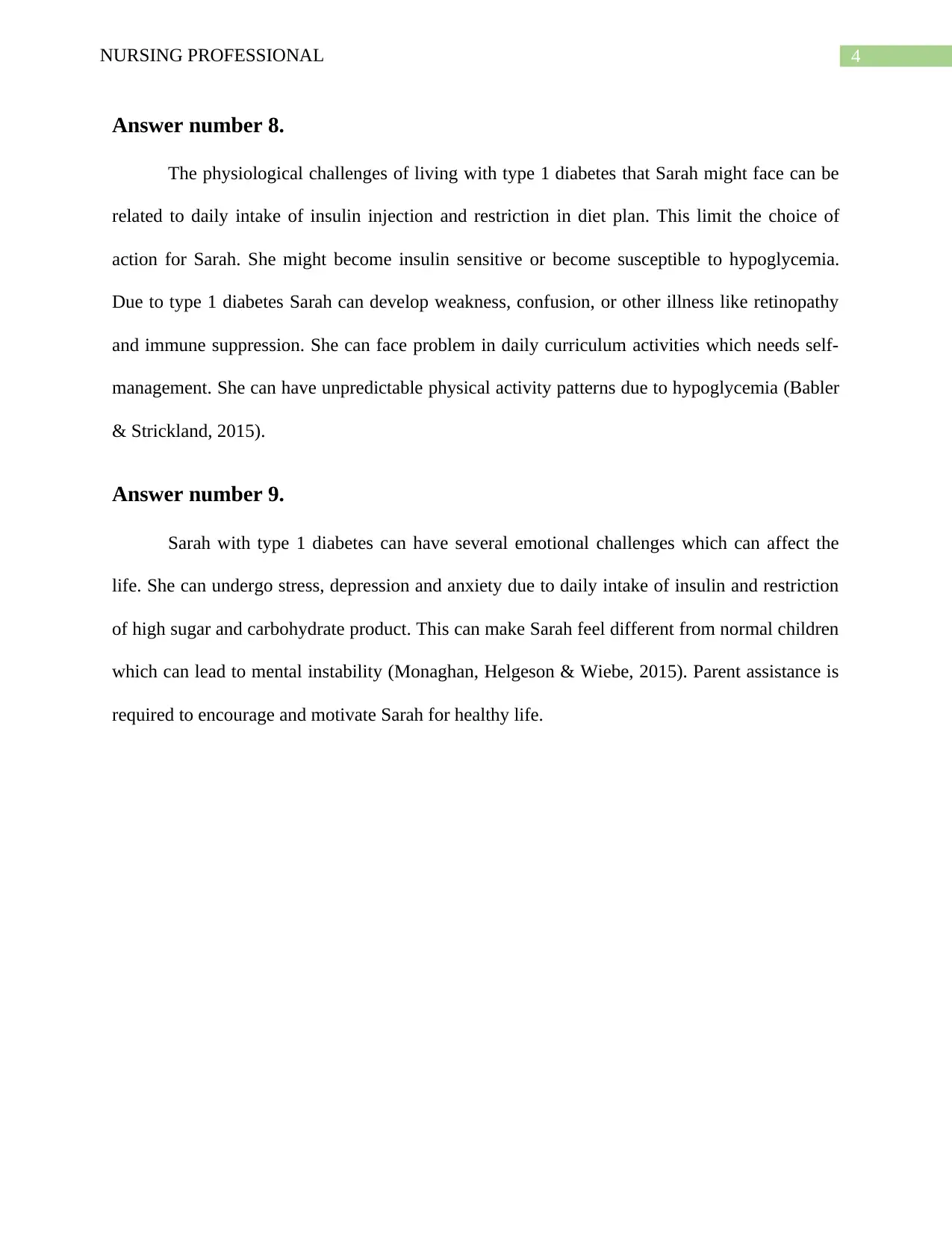
4NURSING PROFESSIONAL
Answer number 8.
The physiological challenges of living with type 1 diabetes that Sarah might face can be
related to daily intake of insulin injection and restriction in diet plan. This limit the choice of
action for Sarah. She might become insulin sensitive or become susceptible to hypoglycemia.
Due to type 1 diabetes Sarah can develop weakness, confusion, or other illness like retinopathy
and immune suppression. She can face problem in daily curriculum activities which needs self-
management. She can have unpredictable physical activity patterns due to hypoglycemia (Babler
& Strickland, 2015).
Answer number 9.
Sarah with type 1 diabetes can have several emotional challenges which can affect the
life. She can undergo stress, depression and anxiety due to daily intake of insulin and restriction
of high sugar and carbohydrate product. This can make Sarah feel different from normal children
which can lead to mental instability (Monaghan, Helgeson & Wiebe, 2015). Parent assistance is
required to encourage and motivate Sarah for healthy life.
Answer number 8.
The physiological challenges of living with type 1 diabetes that Sarah might face can be
related to daily intake of insulin injection and restriction in diet plan. This limit the choice of
action for Sarah. She might become insulin sensitive or become susceptible to hypoglycemia.
Due to type 1 diabetes Sarah can develop weakness, confusion, or other illness like retinopathy
and immune suppression. She can face problem in daily curriculum activities which needs self-
management. She can have unpredictable physical activity patterns due to hypoglycemia (Babler
& Strickland, 2015).
Answer number 9.
Sarah with type 1 diabetes can have several emotional challenges which can affect the
life. She can undergo stress, depression and anxiety due to daily intake of insulin and restriction
of high sugar and carbohydrate product. This can make Sarah feel different from normal children
which can lead to mental instability (Monaghan, Helgeson & Wiebe, 2015). Parent assistance is
required to encourage and motivate Sarah for healthy life.
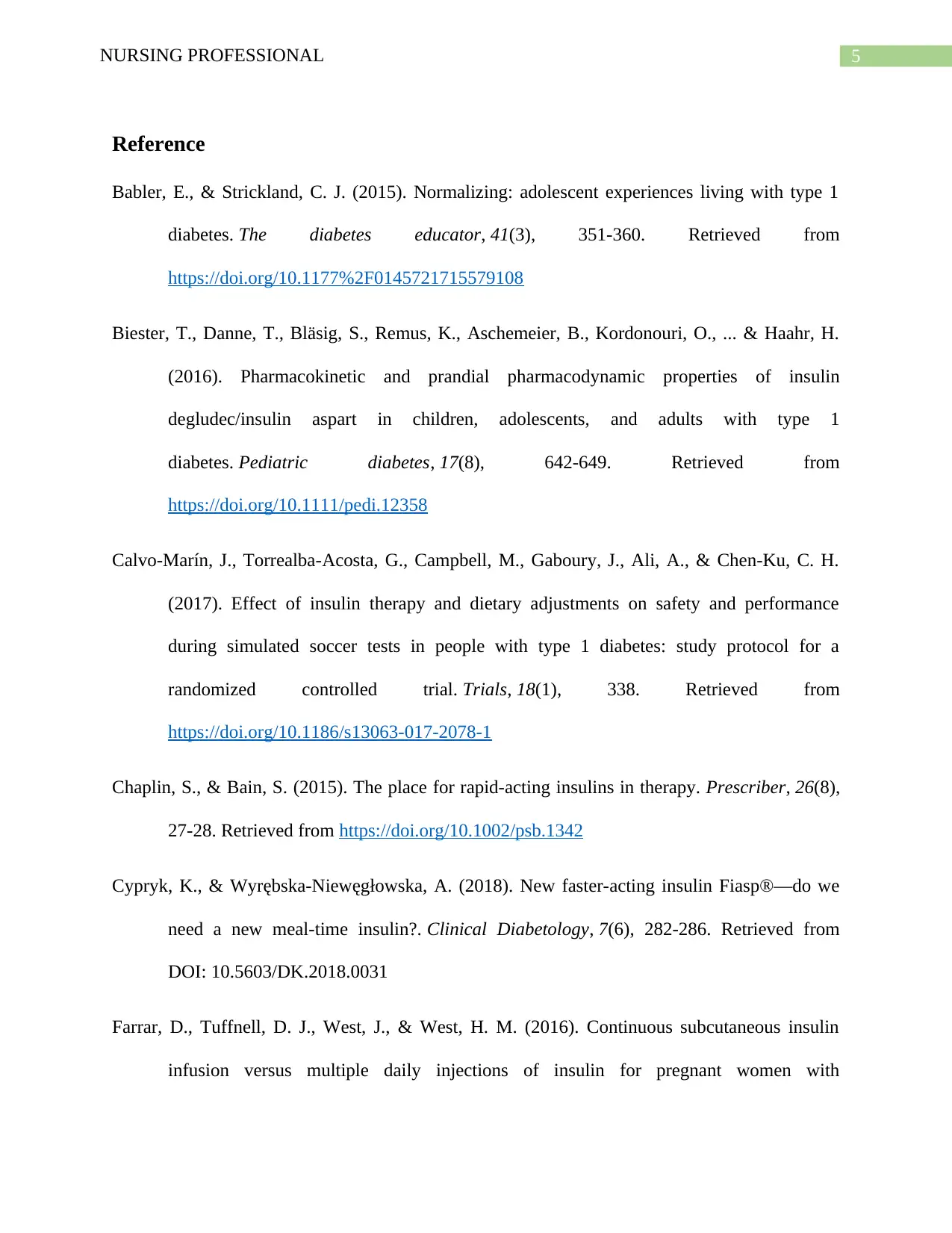
5NURSING PROFESSIONAL
Reference
Babler, E., & Strickland, C. J. (2015). Normalizing: adolescent experiences living with type 1
diabetes. The diabetes educator, 41(3), 351-360. Retrieved from
https://doi.org/10.1177%2F0145721715579108
Biester, T., Danne, T., Bläsig, S., Remus, K., Aschemeier, B., Kordonouri, O., ... & Haahr, H.
(2016). Pharmacokinetic and prandial pharmacodynamic properties of insulin
degludec/insulin aspart in children, adolescents, and adults with type 1
diabetes. Pediatric diabetes, 17(8), 642-649. Retrieved from
https://doi.org/10.1111/pedi.12358
Calvo-Marín, J., Torrealba-Acosta, G., Campbell, M., Gaboury, J., Ali, A., & Chen-Ku, C. H.
(2017). Effect of insulin therapy and dietary adjustments on safety and performance
during simulated soccer tests in people with type 1 diabetes: study protocol for a
randomized controlled trial. Trials, 18(1), 338. Retrieved from
https://doi.org/10.1186/s13063-017-2078-1
Chaplin, S., & Bain, S. (2015). The place for rapid‐acting insulins in therapy. Prescriber, 26(8),
27-28. Retrieved from https://doi.org/10.1002/psb.1342
Cypryk, K., & Wyrębska-Niewęgłowska, A. (2018). New faster-acting insulin Fiasp®—do we
need a new meal-time insulin?. Clinical Diabetology, 7(6), 282-286. Retrieved from
DOI: 10.5603/DK.2018.0031
Farrar, D., Tuffnell, D. J., West, J., & West, H. M. (2016). Continuous subcutaneous insulin
infusion versus multiple daily injections of insulin for pregnant women with
Reference
Babler, E., & Strickland, C. J. (2015). Normalizing: adolescent experiences living with type 1
diabetes. The diabetes educator, 41(3), 351-360. Retrieved from
https://doi.org/10.1177%2F0145721715579108
Biester, T., Danne, T., Bläsig, S., Remus, K., Aschemeier, B., Kordonouri, O., ... & Haahr, H.
(2016). Pharmacokinetic and prandial pharmacodynamic properties of insulin
degludec/insulin aspart in children, adolescents, and adults with type 1
diabetes. Pediatric diabetes, 17(8), 642-649. Retrieved from
https://doi.org/10.1111/pedi.12358
Calvo-Marín, J., Torrealba-Acosta, G., Campbell, M., Gaboury, J., Ali, A., & Chen-Ku, C. H.
(2017). Effect of insulin therapy and dietary adjustments on safety and performance
during simulated soccer tests in people with type 1 diabetes: study protocol for a
randomized controlled trial. Trials, 18(1), 338. Retrieved from
https://doi.org/10.1186/s13063-017-2078-1
Chaplin, S., & Bain, S. (2015). The place for rapid‐acting insulins in therapy. Prescriber, 26(8),
27-28. Retrieved from https://doi.org/10.1002/psb.1342
Cypryk, K., & Wyrębska-Niewęgłowska, A. (2018). New faster-acting insulin Fiasp®—do we
need a new meal-time insulin?. Clinical Diabetology, 7(6), 282-286. Retrieved from
DOI: 10.5603/DK.2018.0031
Farrar, D., Tuffnell, D. J., West, J., & West, H. M. (2016). Continuous subcutaneous insulin
infusion versus multiple daily injections of insulin for pregnant women with
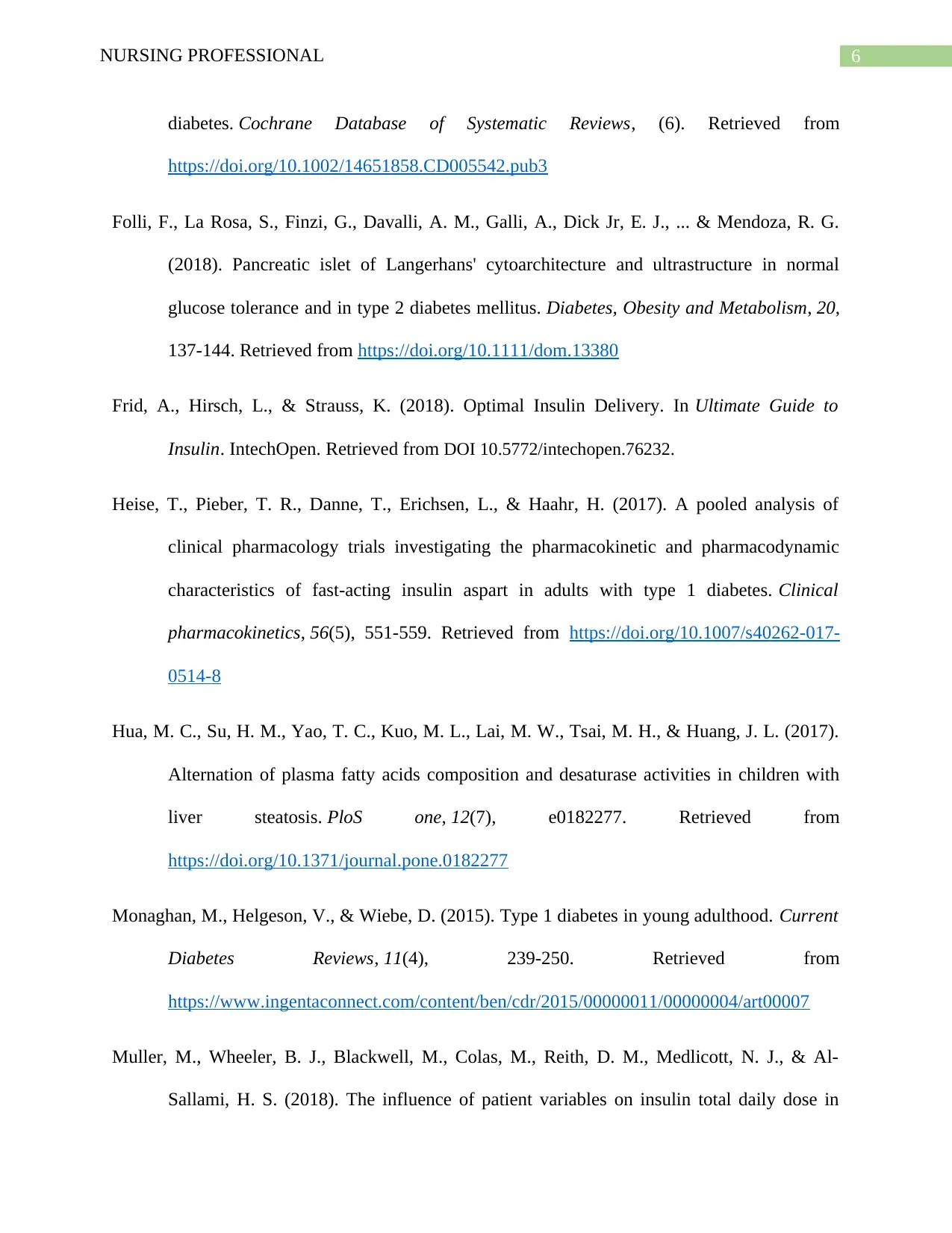
6NURSING PROFESSIONAL
diabetes. Cochrane Database of Systematic Reviews, (6). Retrieved from
https://doi.org/10.1002/14651858.CD005542.pub3
Folli, F., La Rosa, S., Finzi, G., Davalli, A. M., Galli, A., Dick Jr, E. J., ... & Mendoza, R. G.
(2018). Pancreatic islet of Langerhans' cytoarchitecture and ultrastructure in normal
glucose tolerance and in type 2 diabetes mellitus. Diabetes, Obesity and Metabolism, 20,
137-144. Retrieved from https://doi.org/10.1111/dom.13380
Frid, A., Hirsch, L., & Strauss, K. (2018). Optimal Insulin Delivery. In Ultimate Guide to
Insulin. IntechOpen. Retrieved from DOI 10.5772/intechopen.76232.
Heise, T., Pieber, T. R., Danne, T., Erichsen, L., & Haahr, H. (2017). A pooled analysis of
clinical pharmacology trials investigating the pharmacokinetic and pharmacodynamic
characteristics of fast-acting insulin aspart in adults with type 1 diabetes. Clinical
pharmacokinetics, 56(5), 551-559. Retrieved from https://doi.org/10.1007/s40262-017-
0514-8
Hua, M. C., Su, H. M., Yao, T. C., Kuo, M. L., Lai, M. W., Tsai, M. H., & Huang, J. L. (2017).
Alternation of plasma fatty acids composition and desaturase activities in children with
liver steatosis. PloS one, 12(7), e0182277. Retrieved from
https://doi.org/10.1371/journal.pone.0182277
Monaghan, M., Helgeson, V., & Wiebe, D. (2015). Type 1 diabetes in young adulthood. Current
Diabetes Reviews, 11(4), 239-250. Retrieved from
https://www.ingentaconnect.com/content/ben/cdr/2015/00000011/00000004/art00007
Muller, M., Wheeler, B. J., Blackwell, M., Colas, M., Reith, D. M., Medlicott, N. J., & Al-
Sallami, H. S. (2018). The influence of patient variables on insulin total daily dose in
diabetes. Cochrane Database of Systematic Reviews, (6). Retrieved from
https://doi.org/10.1002/14651858.CD005542.pub3
Folli, F., La Rosa, S., Finzi, G., Davalli, A. M., Galli, A., Dick Jr, E. J., ... & Mendoza, R. G.
(2018). Pancreatic islet of Langerhans' cytoarchitecture and ultrastructure in normal
glucose tolerance and in type 2 diabetes mellitus. Diabetes, Obesity and Metabolism, 20,
137-144. Retrieved from https://doi.org/10.1111/dom.13380
Frid, A., Hirsch, L., & Strauss, K. (2018). Optimal Insulin Delivery. In Ultimate Guide to
Insulin. IntechOpen. Retrieved from DOI 10.5772/intechopen.76232.
Heise, T., Pieber, T. R., Danne, T., Erichsen, L., & Haahr, H. (2017). A pooled analysis of
clinical pharmacology trials investigating the pharmacokinetic and pharmacodynamic
characteristics of fast-acting insulin aspart in adults with type 1 diabetes. Clinical
pharmacokinetics, 56(5), 551-559. Retrieved from https://doi.org/10.1007/s40262-017-
0514-8
Hua, M. C., Su, H. M., Yao, T. C., Kuo, M. L., Lai, M. W., Tsai, M. H., & Huang, J. L. (2017).
Alternation of plasma fatty acids composition and desaturase activities in children with
liver steatosis. PloS one, 12(7), e0182277. Retrieved from
https://doi.org/10.1371/journal.pone.0182277
Monaghan, M., Helgeson, V., & Wiebe, D. (2015). Type 1 diabetes in young adulthood. Current
Diabetes Reviews, 11(4), 239-250. Retrieved from
https://www.ingentaconnect.com/content/ben/cdr/2015/00000011/00000004/art00007
Muller, M., Wheeler, B. J., Blackwell, M., Colas, M., Reith, D. M., Medlicott, N. J., & Al-
Sallami, H. S. (2018). The influence of patient variables on insulin total daily dose in
Paraphrase This Document
Need a fresh take? Get an instant paraphrase of this document with our AI Paraphraser
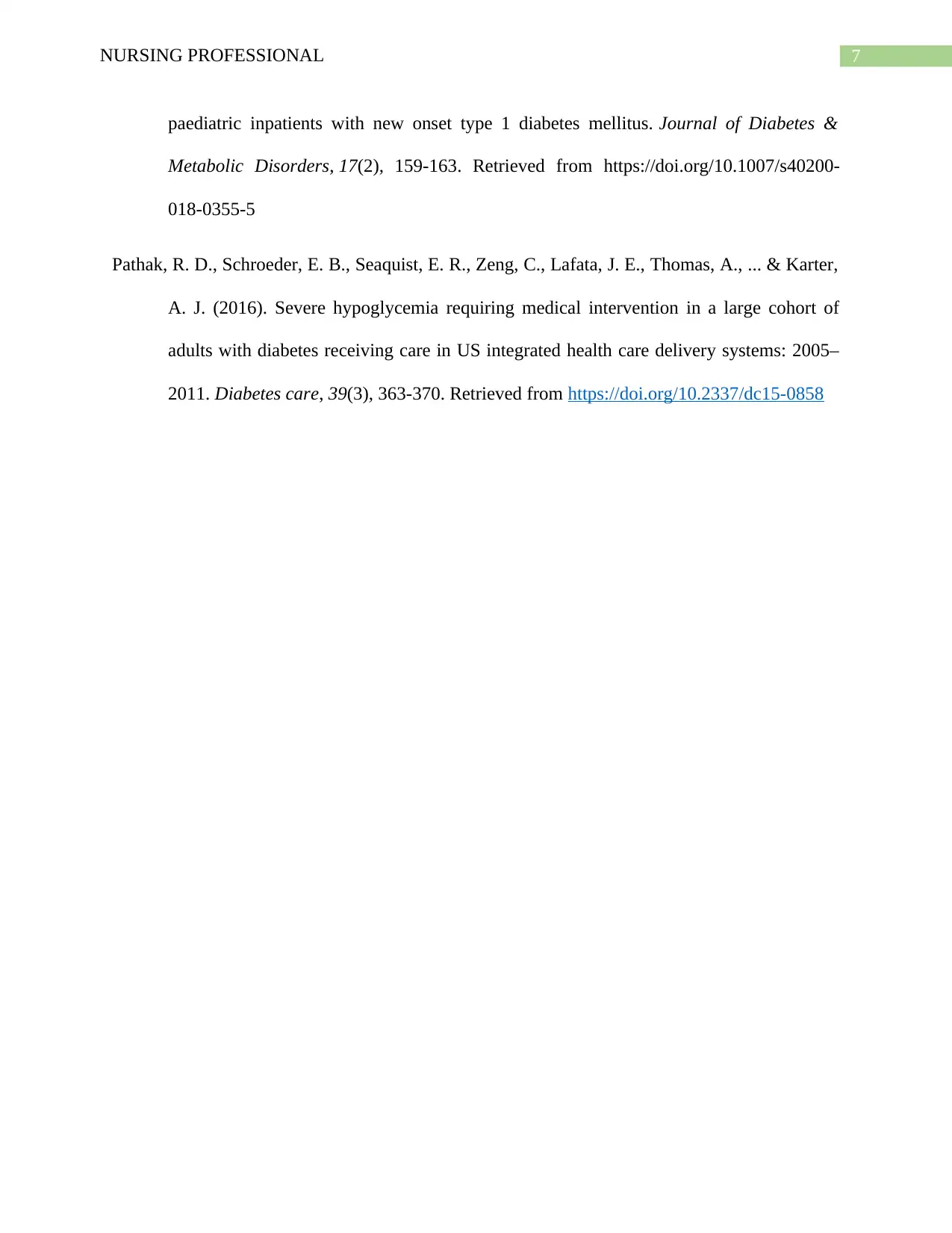
7NURSING PROFESSIONAL
paediatric inpatients with new onset type 1 diabetes mellitus. Journal of Diabetes &
Metabolic Disorders, 17(2), 159-163. Retrieved from https://doi.org/10.1007/s40200-
018-0355-5
Pathak, R. D., Schroeder, E. B., Seaquist, E. R., Zeng, C., Lafata, J. E., Thomas, A., ... & Karter,
A. J. (2016). Severe hypoglycemia requiring medical intervention in a large cohort of
adults with diabetes receiving care in US integrated health care delivery systems: 2005–
2011. Diabetes care, 39(3), 363-370. Retrieved from https://doi.org/10.2337/dc15-0858
paediatric inpatients with new onset type 1 diabetes mellitus. Journal of Diabetes &
Metabolic Disorders, 17(2), 159-163. Retrieved from https://doi.org/10.1007/s40200-
018-0355-5
Pathak, R. D., Schroeder, E. B., Seaquist, E. R., Zeng, C., Lafata, J. E., Thomas, A., ... & Karter,
A. J. (2016). Severe hypoglycemia requiring medical intervention in a large cohort of
adults with diabetes receiving care in US integrated health care delivery systems: 2005–
2011. Diabetes care, 39(3), 363-370. Retrieved from https://doi.org/10.2337/dc15-0858
1 out of 8
Related Documents
Your All-in-One AI-Powered Toolkit for Academic Success.
+13062052269
info@desklib.com
Available 24*7 on WhatsApp / Email
![[object Object]](/_next/static/media/star-bottom.7253800d.svg)
Unlock your academic potential
© 2024 | Zucol Services PVT LTD | All rights reserved.





